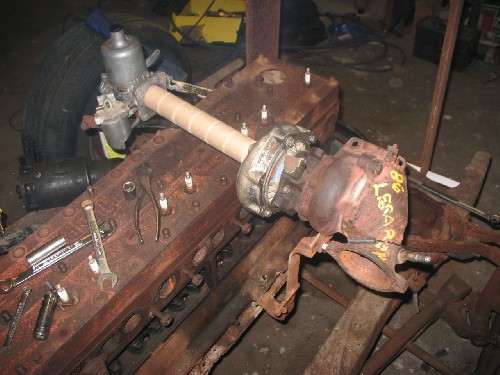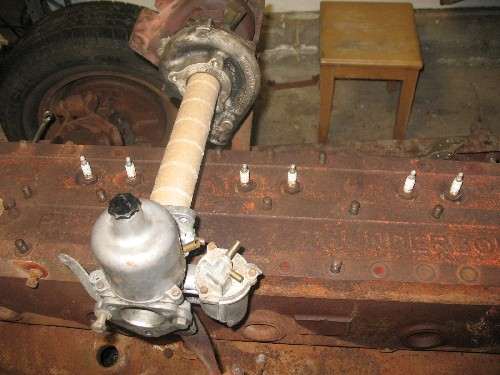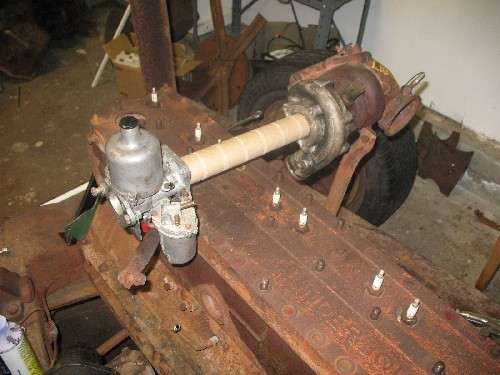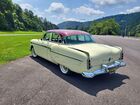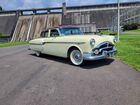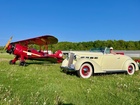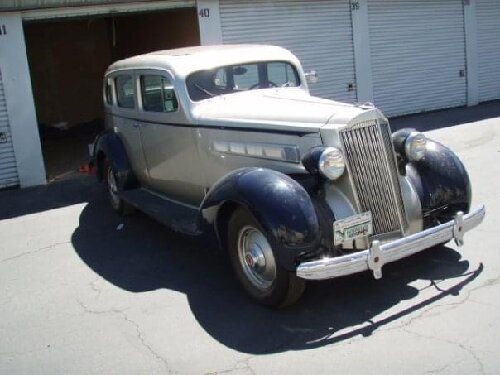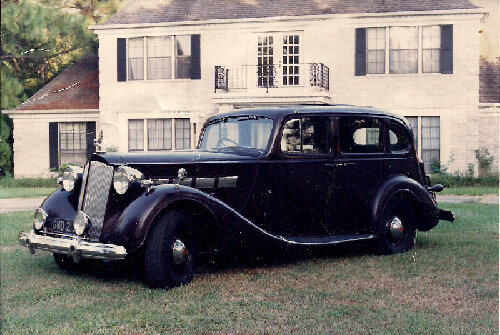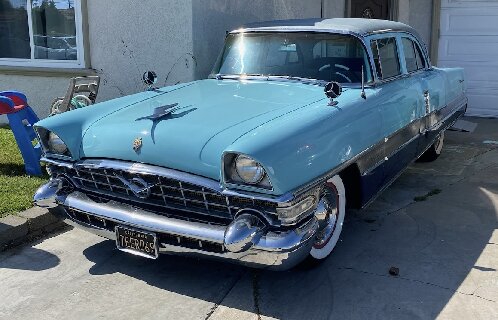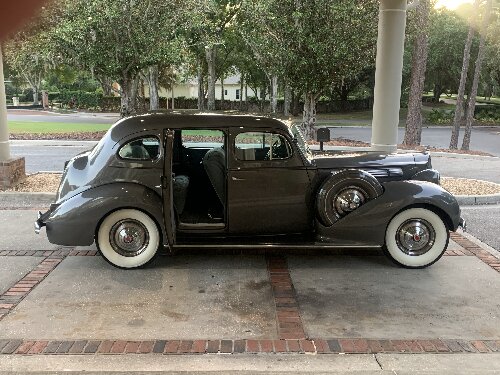|
Re: The Second Packard "Twin Six"
|
||||
|---|---|---|---|---|
|
Quite a regular

|
John - you did fine in your disc. of what you read on tech. info. on the 1930's era Packard V-12.
To add to your discussion, let me explain more about the layout of the combustion chamber and induction and exhaust systems, and why all this resulted in a MUCH more raw power at the rear wheels, then either of the two Cadillac V-16s (the earlier over-head valve one, and the 1938-40 "flat head") (both of which were significantly smaller than the Packard V-12. Incidentally, Auburn, to my knowledge, did not have much to do with its own V-12. That was a Lycoming design, engineered and built in the Lycoming shops. About the size of a Packard Super Eight. Good engine - tooling purchased by American La France and, with some mods, used for many years in their smaller fire engines. But NOWHERE near the raw power of a Packard V-12 (as a side note, the Pierce Arrow V-12, about the same size as the Packard V-12, lived on clear into the early 1960's, in smaller Seagrave fire engines. Anyway, the key to understanding the genius of Packard engineers (again, not Van Ranst - he was a DRIVE-LINE engineer - I dont know what, if anything, he had to do with power-plant design ? ? ? ? ) is to look at a cross-section of the Packard V-12. First, you see that the top of the block is NOT directly 90 degrees to the bores. It is at an ANGLE, permitting a wedge-shaped combustion chamber. This, coupled with "wedge shaped" pistons, gives vastly superior "burn" characteristics to an ordinary "flat head". Secondly, look at the induction system. As to the intake manifold, note that it was one of the first, if not THE first, attempts at what Chrysler, some 20 years later, called "ram induction". meaning a balanced even flow. The Stromberg EE-3 carb. was, if my understanding is correct, the largest 'swept volume" of any automotice carb. until the four barrels of the 1950's. Thus the Packard Twelve could BREATHE. Look at how much smaller the carbs and their volume were, on any other big multi-cyl. luxury car of that era, and you can see why, bone stock, I had much sadistic fun "blowing the doors" off of other big classic car owners when we were wild kids in the first years of the Classic Car Club Of America. Now look at the exhaust system. I am unaware of ANY production auto motor of that era where they went to such great pains to have unrestricted "breathing". Bottom line - you got a damn good buy when you bought a Packard.
Posted on: 2008/9/18 8:43
|
|||
|
||||
|
Re: Packard run - not quite!
|
||||
|---|---|---|---|---|
|
Quite a regular

|
Bev - I am pretty lame with computers. Seems to work now. I'll try and let you know SOMEHOW if I have trouble with this thing in the future.
Pete Hartmann
Posted on: 2008/9/18 8:23
|
|||
|
||||
|
Re: V-8 head part nbr vs cast nbr
|
||||
|---|---|---|---|---|
|
Home away from home

|
"As for the heads on my 1955 320 Hash engine, part # is 440854, these are the long-reach spark plug, fully machined heads.."
According to Service Counselor page 41 (probably Vol 29 #12 Nov 15 55) the 440854 should be CAST dome with 3/4 inch spark plug hole.
Posted on: 2008/9/18 6:36
|
|||
|
||||
|
Re: Eric's 1925 Packard Barchetta Speedster Project
|
||||
|---|---|---|---|---|
|
Home away from home

|
Reason, yes. But sometimes when you visualize something that someone else has already tried to visualize, the two ideas get mixed up and both parties are confused. Nothing better than a few pics to clear things up a bit!
And I take the "stubborn bastard" comment as a compliment, as my wife calls me that ALL the time!
Posted on: 2008/9/18 4:03
|
|||
|
||||
|
Re: Eric's 1925 Packard Barchetta Speedster Project
|
||||
|---|---|---|---|---|
|
Forum Ambassador
|
Quote:
Turbopackman wrote:.......Whatcha all think?....... Funny that you ask, Eric but for some reason I like it!  Quote: I think Mal came up with this idea months ago,....... But now that I look at it, I actually like it! Ohhhhhh, So that's the reason I like it, it's my idea. You are a stubborn bastard Eric, but reason finally prevailed.
Posted on: 2008/9/18 3:57
|
|||
|
Mal
/o[]o\ ====  Bowral, Southern Highlands of NSW, Australia "Out of chaos comes order" - Nietzsche. 1938 Eight Touring Sedan - SOLD 1941 One-Twenty Club Coupe - SOLD 1948 Super Eight Limo, chassis RHD - SOLD 1950 Eight Touring Sedan - SOLD What's this?  Put your Packard in the Packard Vehicle Registry! Here's how! Any questions - PM or email me at ozstatman@gmail.com |
||||
|
||||
|
Re: Eric's 1925 Packard Barchetta Speedster Project
|
||||
|---|---|---|---|---|
|
Home away from home

|
After much thought on how to mount the turbo's and the carbs, and even considering drawing from one single 4bbl carb in between the two turbos, I did some head scratching tonight out in the garage, and decided that this would be the best way to go, so I mocked it up. Now, the turbo's will sit higher than it is in this pic, about 3" or 4" or so, hopefully no higher. Also, forgive my use of the paper towel roll, but it's the perfect size for the inside of both the turbo intake and the HS6 intake. The beauty of all this is that it solves a multitude of problems, and keeps the carb away from the heat of the turbo's. It also allows me to have plenty of room to run carb linkage, oil lines, and coolant lines for the turbo's. And since I plan on using an electric fuel pump, the fuel line can run on the driver's side of the car, so I won't have to run around in front of the engine with a fuel line from the fuel pump. Whatcha all think?
P.S., I think Mal came up with this idea months ago, but I didn't want to do it because I didn't want the carbs to go over the engine. But now that I look at it, I actually like it!
Posted on: 2008/9/18 3:27
|
|||
|
||||
|
Re: V-8 head part nbr vs cast nbr
|
||||
|---|---|---|---|---|
|
Home away from home

|
Ok, got out into the garage tonight to look at my stuff, and here goes:
320 crankshaft, no markings other than "K" and "4" on the last balance weight by the rear main, see attached pic. 320 Rods: part # on my rod is 440774, then a "P" in a box, then a 7. On the other side if the rod is "E558", no other markings. On my 374, I can't see anything anywhere, which leads me to believe that it's the same as my 320 crank. As a side note however, on my 320 crank, there are numerous places where material has been machined off, presumably to adjust the weight. As for the heads on my 1955 320 Hash engine, part # is 440854, these are the long-reach spark plug, fully machined heads. The parts engine I have has the cast dome heads, IIRC.
Posted on: 2008/9/18 0:52
|
|||
|
||||
|
Re: The Second Packard "Twin Six"
|
||||
|---|---|---|---|---|
|
Home away from home

|
Packard53
Who was the outside source that designed the twin 6? I thought that Col. Vincent designed and built the prototypes and convinced Packard execs to build it.
Posted on: 2008/9/17 23:47
|
|||
|
North Hills Packards
2 - 1949 Super Convertibles 1949 Club Sedan 1947 Custom Sedan Completed a book on the 22nd & 23rd series cars |
||||
|
||||
|
Re: 1940 110 Compression
|
||||
|---|---|---|---|---|
|
Home away from home

|
Removing all the plugs and cranking the engine is the standard practice to check compression. It lets the engine spin freely and gives an accurate reading to compare with factory specs.
Owen is right, you can tell a great deal about the condition of an engine by running compression checks as he specified. If you try it again I feel sure you will be pleasantly surprised at the difference.
Posted on: 2008/9/17 23:40
|
|||
|
North Hills Packards
2 - 1949 Super Convertibles 1949 Club Sedan 1947 Custom Sedan Completed a book on the 22nd & 23rd series cars |
||||
|
||||


 (7.54 KB)
(7.54 KB)
